|
 Secure Site
Secure Site
|
 |
Archive for the 'mindfulness practice' Category
 mindful walking Whether you’re staring at a blank page or stuck on a problem, a walk may be just the thing you need to bust through a roadblock. It can even set the stage for inspired thinking and major mental breakthroughs, says Thom Hartmann, author of “Walking Your Blues Away,” by giving you access to the full range of your thought power. “When we walk, we stimulate portions of the brain in the right and left hemispheres, giving us access to more areas of our brains than when we’re sitting still,” he explains. “A million years of evolution have equipped our bodies to operate in an optimal way when we’re walking,” he says. “It’s part of our body’s normal restorative process.” Here are his guidelines for using your daily walk to get out of a mental rut and lure your creativity out into the open.
Skip the Distractions
Wear comfortable clothing, don’t carry anything, and leave the iPod at home. This helps you stay open and balanced so you can focus.
Set a Comfortable Pace
Walk at your normal pace, which helps you sync to your body’s other rhythmic processes, such as heartbeat and breathing rate, which further creates the conditions for insight to occur.
Visualize Your Dilemma
As you’re walking, call up the issue or idea you need clarity on. It can be as richly detailed as a mental image (seeing the finished letter, signed and sealed) or as simple as a question (“What should I say to this person?”). Your mind will inevitably wander; let it. Then, gently guide your thoughts back. Hartmann explains that this interplay between conscious thinking (going over the main points in your mind) and unconscious thinking (daydreaming) brings your whole brain into play and opens you up to inspiration.
Take Your Time
According to Hartmann, the average length of time people require to have a burst in creativity is 15 minutes, or about a mile of walking.
adapted from Body + Soul Magazine, September 2007 by Katie Hanley
 Digital Zen Alarm Clocks, meditation timers and alarm clocks with chimes
Now & Zen
1638 Pearl Street
Boulder, CO 80302
(800) 779-6383
Posted in Chime Alarm Clocks, intention, mindfulness practice, Now & Zen Alarm Clocks, Well-being, Zen Timers
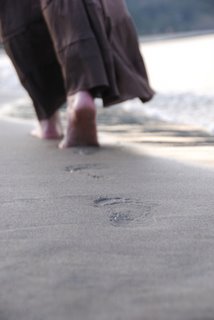 meditation in motion, walking mindfulness practice Attention, multitaskers: Want to exercise and meditate at the same time? Try Breathwalk, a form of walking meditation that incorporates pranayama and mantra techniques from the Kundalini Yoga tradition. The late Yogi Bhajan introduced this practice to the West in the early 1970s. Since then, yoga students of all shapes and sizes have used it to improve their cardiovascular health, tone their nervous system, boost their energy, stabilize their moods, quiet mental chatter, and embrace the present moment. In its full form, Breathwalk is a five-step process that can take up to 60 minutes; here’s an abbreviated routine you can do in less than 20. Try it in a meadow, on the beach, in the woods, or, if you’re feeling adventurous, on a city street.
The Practice
Begin walking at a normal pace, observing your bodily sensations. Then tune into your breath. Are you breathing with your chest muscles or with your diaphragm? Is your breath shallow and erratic or smooth and deep? Noisy or quiet? Through your mouth or through your nostrils? Gradually refine your breath so that it becomes nasal, diaphragmatic, and free of noise and irregularities.
Now coordinate your breath with your stride, inhaling for four steps and exhaling for four steps. When this feels comfortable and automatic, begin to practice the following breathing pattern: Keeping your nasal passages and facial muscles relaxed, take four short staccato puffs of air through the nostrils—one puff for each step. (Your breath will be audible now; focus on the sound.) Essentially, you are dividing your inhalation into four segments that are synchronized with four consecutive steps. After the first puff, your lungs should be about one-quarter full; after the second, two-quarters full; after the third, three-quarters full; and after the fourth, four-quarters full.
 zen stones Without pausing, exhale in the same fashion, contracting the abdominal muscles and pushing the navel to the spine for four steps (and four segments of the out-breath), so that the final puff pushes the last quarter of air out of your lungs. Continue this pattern for five minutes, then walk and breathe normally for three minutes. As Gurucharan Singh Khalsa, senior student of Yogi Bhajan and co-author of Breathwalk, says, “It’s not about, ‘How far did I walk, how many calories did I burn, how much effort was expended?’ It’s about synchronizing the body, breath, and mind to the present moment, about experiencing a profound sense of connection with yourself and nature.”
Now, repeat the eight-minute practice. This time, as you synchronize your segmented breath with your stride, mentally say the mantra sa ta na ma—one sound for each step and each segmented breath. Repeat the mantra in coordination with the quartered breath for five minutes, then walk and breathe normally for another three.
“Practice for three days in a row and you’ll feel the energizing, focusing effects immediately,” Khalsa says. “If you do it for 40 days you can get really intimate with the technique. You can slip it into the cracks of your day to support you—that’s its purpose.”
adapted from Yoga International, by Shannon Sexton
 Tibetan Meditation Timer with Brass Singing Bowl Now & Zen
1638 Pearl Street
Boulder, CO 80302
(800) 779-6383
Posted in Bamboo Chime Clocks, Meditation Timers, Meditation Tools, mindfulness practice, Now & Zen Alarm Clocks, Zen Timepiece by Now & Zen, Zen Timers
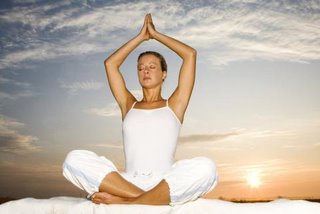 Lake Meditation Lake Meditation
Move your attention from the mountain to the lake. Crystal-clear, turquoise-hued lakes toward the peak of some mountains in the Himalayas are called “sky lakes” because they so perfectly reflect the sky above. Protected by the higher peaks and trees, the surface of such a lake is smooth and calm. You don’t need to visualize yourself as a lake. Rather, contemplate the lake and its quality of reflectivity. Notice how the water is translucent, allowing you to see into its depths. Notice how it is also as reflective as a mirror, so you can see your face and the sky above on its surface. As you imagine yourself looking into the surface of the water, notice how the water reflects only what is there, neither editing out nor adding in anything. The water reflects the dark, ominous storm clouds and the fluffy white clouds equally. When birds fly overhead, the water reflects them; yet once they are gone from the sky, it shows no trace of them.
When the waves (vritti) are calmed, the mind (citta) has this dual ability of the lake to be both translucent and reflective. Once your mind is stabilized, you can turn your attention to it. Imagining your mind to be as translucent and reflective as the sky lake may bring forth thoughts, feelings, and emotions, but you can simply reflect what arises without judging or comparing, and without editing out anything through aversion or denial. Perceptions of sound, smell, or touch may arise, and, free of grasping and pushing away, you can simply reflect. In this way, destructive or unwholesome patterns can be seen, so that their power over you is lessened. Attachments are loosened. Breathing in, see yourself as the water of the sky lake; breathing out, reflect.
adapted from Yoga Journal, by Frank Jude Boccio
 Zen Chime Alarm Clock and Timer Now & Zen
1638 Pearl Street
Boulder, CO 80302
(800) 779-6383
Posted in Bamboo Chime Clocks, intention, Meditation Timers, Meditation Tools, mindfulness practice, Now & Zen Alarm Clocks
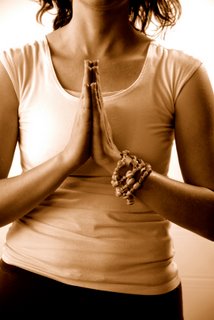 giving thanks Cultivating gratitude can boost well-being—and may help you sleep better.
Gratitude is a fundamental component of most spiritual paths, and a growing body of research suggests that it has important health implications, too, including better sleep, fewer physical ailments, and a greater ability to cope with stressful situations.
“Gratitude elevates, it energizes, it inspires, it transforms,” says Robert Emmons, a University of California, Davis, psychology professor who has helped champion the study of gratitude as a factor in mental and physical health.
A series of studies he conducted in 2003 found that people who kept weekly written records of gratitude slept longer, exercised more frequently, had fewer health complaints, and generally felt better about their lives when compared with those who were asked to record only their complaints. In another study, he found that students who wrote in gratitude journals felt more satisfied with their lives and their school experience.
Practicing conscious gratitude has also been linked with positive mental health. Todd Kashdan, associate professor of psychology at Virginia’s George Mason University, found that when veterans with posttraumatic stress disorder kept gratitude journals, they experienced a greater sense of overall well-being in their lives. “There are two parts of being grateful,” Kashdan says. “One is recognizing that someone benefited in some way, then mindfully seeing the connection to yourself. You have to really be in the present to see what’s happening in your life, what’s causing things to happen, and how you fit into things bigger than yourself.”
A gratitude practice is a natural companion to yoga, which “offers numerous opportunities to reflect on all there is in one’s life to be grateful for,” says Emmons. To begin consciously cultivating gratitude, try considering what life would be like without a pleasure you now enjoy, or think about who you are grateful for. A daily gratitude journal can help you be more mindful of these things in your life. But your gratitude practice doesn’t have to be scripted: Simply taking time on a regular basis to mentally note your blessings is a big step in the right direction.
adapted from Yoga Journal, by Jill Duman
Posted in Bamboo Chime Clocks, Chime Alarm Clocks, intention, mindfulness practice, Now & Zen Alarm Clocks
 Silk Lavender Eye Pillows Creating Eye Pillows:
Summer holidays are perfect times for craft projects. Here’s one you can do in an hour and use right away. Eye pillows are handy for traveling and for relaxing in Savasana.
Materials You’ll Need (makes one eye pillow)
For the pillow
1/2 yard of fabric that has been washed, dried, and ironed
For the filling
1/2 cup dried beans or flax seeds
1/2 cup dried rice, lentils, or buckwheat
1/2 cup dried lavender or chamomile
When selecting the filling consider the recipient’s scent preferences and any potential allergies. Mix together three or all of the above items. You’ll need 1 1/2 cups total.
 creating beautiful eye pillows Make the Pillow
Step 1 Cut the fabric
Using a ruler and pencil, mark two 4 1/2-by-10-inch rectangles on the wrong (nonprinted) side of the fabric. With a pair of scissors, cut along the marks to create the two panels needed for the pillow.
Step 2 Sew the seams
Place the two panels’ right (printed) sides together, with the raw edges aligned. Stitch a 1/2-inch seam around the raw edges, backstitching (sewing first in reverse, then forward over the same stitches) at each end. Leave one of the 4-inch sides open, so you can later add the filling. Stitch a 3/8-inch reinforcement seam around the raw edges, leaving the same 4-inch opening. This reinforcement will ensure that the mixture doesn’t leak out of the pillow after you’ve filled it.
With your scissors, cut two 1/4-inch notches in each seam allowance (the area between the stitching and the raw, cut edge of the fabric), one on either side of each of the four corners, making sure not to clip the stitching. Turn the eye pillow right side out for the next step.
Step 3 Fill the pillow
Spoon 1 1/2 cups of filling into the pillow’s open seam.
Step 4 Close the final seam
Fold each side of the remaining 4-inch seam 1/2 inch toward the inside of the pillow, and pin the opening closed. Either by hand or with a sewing machine, stitch a seam across the folded edges to close the 4-inch opening, then try out the pillow: Set your Zen Meditation Timer to 5 minutes, lie down, put it over your eyes, and treat yourself to 5 minutes of deep relaxation.
adapted from Yoga Journal, by Victoria Everman
 Zen Mediation Timers Now & Zen
1638 Pearl Street
Boulder, CO 80302
(800) 779-6383
Posted in Chime Alarm Clocks, Meditation Timers, Meditation Tools, mindfulness practice, Now & Zen Alarm Clocks, Well-being, Zen Timers
 Reiki Treatment Reiki, a Japanese healing treatment, quiets the body and spirit by tapping into a “life force.”
“Universal life energy” is what Reiki (pronounced RAY-kee) means in Japanese. Reiki practitioners use this energy-the subtle vibrational force that surrounds and permeates every living thing- to enhance and balance the body, says Susan Mitchell, a Reiki master and owner of Reiki Healing Arts in Coeur d’Alene, Idaho. “The practitioner acts as a conduit,” explains Beth White, a Reiki master in New York City. “During a session, the energy flows through the practitioner’s hands and you absorb it on a physical, mental, emotional, and spiritual level.” The result? A feeling of meditative peace.
Evidence
Reiki originated in Japan in the 1920s and was brought to the United States in the 1930s by Hawayo Takata, a Japanese-American. Although the studies of Reiki thus far have been small (five larger ones sponsored by the National Institutes of Health are under way), they indicate-as does strong anecdotal evidence-that the method is effective at reducing pain, anxiety, and stress, and increasing a sense of wellbeing. A study published last year in Integrative Cancer Therapies compared the effects of Reiki treatments with the effects of rest on fatigue, pain, anxiety, and overall quality of life in 16 cancer patients. Researchers found that the individuals who received Reiki experienced increases in quality of life and decreases in fatigue, changes that were not seen with rest alone.
Pamela Miles, a Reiki master in New York City and author of Reiki: A Comprehensive Guide (Tarcher, 2006), says the physiological changes seen following a Reiki session include a healthy decrease in heart rate and blood pressure and an increase in salivary immune hormones. “Reiki can help make your body’s self healing mechanism more effective,” she says. “Universal life energy” is what Reiki (pronounced RAY-kee) means in Japanese. Reiki practitioners use this energy-the subtle vibrational force that surrounds and permeates every living thing- to enhance and balance the body, says Susan Mitchell, a Reiki master and owner of Reiki Healing Arts in Coeur d’Alene, Idaho. “The practitioner acts as a conduit,” explains Beth White, a Reiki master in New York City. “During a session, the energy flows through the practitioner’s hands and you absorb it on a physical, mental, emotional, and spiritual level.” The result? A feeling of meditative peace.
 Reiki Evidence
Reiki originated in Japan in the 1920s and was brought to the United States in the 1930s by Hawayo Takata, a Japanese-American. Although the studies of Reiki thus far have been small (five larger ones sponsored by the National Institutes of Health are under way), they indicate-as does strong anecdotal evidence-that the method is effective at reducing pain, anxiety, and stress, and increasing a sense of wellbeing. A study published last year in Integrative Cancer Therapies compared the effects of Reiki treatments with the effects of rest on fatigue, pain, anxiety, and overall quality of life in 16 cancer patients. Researchers found that the individuals who received Reiki experienced increases in quality of life and decreases in fatigue, changes that were not seen with rest alone.
Pamela Miles, a Reiki master in New York City and author of Reiki: A Comprehensive Guide (Tarcher, 2006), says the physiological changes seen following a Reiki session include a healthy decrease in heart rate and blood pressure and an increase in salivary immune hormones. “Reiki can help make your body’s self healing mechanism more effective,” she says.
A typical session
During a Reiki treatment, you lie down on a massage table while the practitioner places her hands in various positions on your head, throat, and front and back torso. (Clients are fully clothed, unless Reiki is used in combination with another treatment like a massage.) You may enter a state of deep relaxation. Many people report seeing colors and moving shapes, sensing pulsations, and feeling hot or cold. In many cases, though, the result is improved energy and a sense of wellbeing. “I go into what feels like a deep sleep,” says Spiegler, “and an hour later I ‘wake up,’ feeling totally rejuvenated.”
adapted from Natural Health Magazine, August 2008 by Susan Hayes
 Bamboo Digital Chime Clock, a Reiki Timer and Clock Now & Zen
1638 Pearl Street
Boulder, CO 80302
(800) 779-6383
Posted in Bamboo Chime Clocks, Chime Alarm Clocks, intention, Japanese Inspired Zen Clocks, mindfulness practice, Now & Zen Alarm Clocks, Well-being
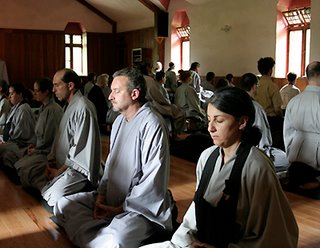 zen mountain monastery Across the country, hundreds of retreats, monasteries, cloisters, and abbeys located in out-of-the-way places—and some in unexpected city settings—offer sanctuary and stress relief to all who seek it. No matter which retreat you choose, one thing is universal to the experience: The tools needed to balance mind, body, and spirit come with the room.
Mark Perew, a Santa Ana, California, programmer, says he keeps returning to St. Andrews, a Benedictine abbey in Valyermo, California, because his visits change the way he views himself. “There I learned I can be by myself, but I don’t have to be alone,” he says. “The monks follow a regimen of prayer, singing, and silence. Entering into that pattern helps me get in tune with the spiritual presence.”
Although the motivations of sanctuary visitors are as unique as their personalities and histories, those who host them notice a common theme. “A word we often see written in our registry book is peace,” says Brother Raphael Prendergast of the Abbey of Gethsemani in Trappist, Kentucky.
The quiet, often remote settings allow for introspection, reconnection, stress relief, and a flowering of inherent wisdom. “Here guests get themselves back,” says Ryushin Marchaj, a senior monastic at Zen Mountain Monastery in Mt. Tremper, New York. “People recognize their own strength, their vastness, and their foibles.”
Most Zen monasteries begin and end every day with zazen, several hours of sitting meditation. Guests who have few opportunities for silence in their regular lives find this very powerful. Leslie Farmer, a journalist who stayed at Green Dragon Zen Monastery in Sausalito, California, says the meditation aspect gave her the sense she’d stepped into another culture. “This place had a peaceful atmosphere you can’t find at a hotel,” she says. Remeber to bring your Zen Timer for your mindufulness practice.
 green gulch zen monastery Finding Sanctuary
ABBEY OF GETHSEMANI
Trappist, Kentucky
(502) 549-3117; Monks.org
Thomas Merton spent twenty-seven years writing and becoming a spiritual master at this monastery in the Kentucky hills. Monks make meatless meals for guests at this silent retreat (speaking is permitted only in designated areas). Accommodations include private room and bath.
CASA DE MARIA
Santa Barbara, California
(805) 565-9062; LaCasaDeMaria.org
Two retreats in one, the interfaith center includes El Bosque and Ladera, both nestled in the foothills of the Santa Ynez Mountains overlooking the Pacific Ocean. Dormitory and private rooms and meals are available.
HOLY CROSS ABBEY
Berryville, Virginia
(540) 955-4383; HolyCrossAbbeyBrryvlle.org
At this Blue Ridge Mountain monastery, members of the Cistercian Order of the Strict Observance of Trappist Monks bake fruitcakes and make preserves, creamed honey, and fudge. Guesthouse accommodations are available.
PENDLE HILL
Wallingford, Pennsylvania
(800) 742-3150; PendleHill.org
This Quaker center for study and contemplation is set among woodland that includes 150 different tree species, an organic garden, and a straw bale greenhouse.
SAINT ANDREW’S ABBEY
Valyermo, California
(661) 944-2178; Valyermo.com
This Benedictine monastery and self-directed retreat center offers rooms and home-style food shared with the monastic community (silent breakfasts and dinners). Guests are welcome to join the monks in prayer and chanting.
ZEN MOUNTAIN MONASTERY
Mt. Tremper, New York
(845) 688-2228; MRO.org
Located on a nature preserve in the Catskill Mountains, this monastery offers several levels of visitation, from weekend introductions to Zen Buddhism to monthly meditation intensives. Guests must join the monastic community and are required to participate in all activities.
 Zen Chime Alarm Clock, zen meditatin timer
adapted from Natural Home Magazine, Jan/Feb 2005 by
Judith Stock
Now & Zen
1638 Pearl Street
Boulder, CO 80302
(800) 779-6383
Posted in Japanese Inspired Zen Clocks, mindfulness practice, Well-being
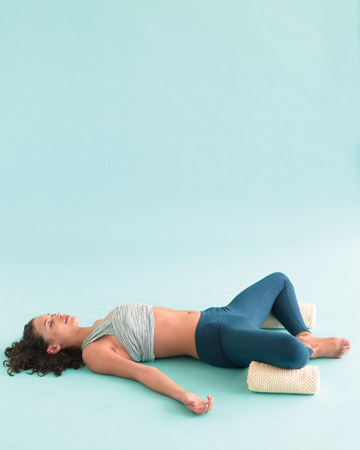 yoga get grounded pose Wednesday: Get Grounded
If a midweek slump has left you out of steam, get back on track by carving out a moment of calm. This easy reclining pose does just that, with an ultra-relaxing stretch that helps you get out of your head.
Supported Goddess
What It Does
Releases tight hips, stretching the groin muscles; connects you to the grounding energy of the root chakra, located at the base of your spine.
How to Do It
Set your Zen Yoga Timer for 5 minutes so that the chime will end your practice peacefully. Lie on your back with the bottoms of your feet touching and knees splayed to the sides, resting on pillows or rolled blankets. Feel your spine on the floor.
Place your palms on your belly or rest your arms out to the sides, palms up. Let your belly slowly rise and fall with each breath. Remain here for 5 minutes, or however long you like.
adapted from Body + Soul, 2010
 Digital Zen Yoga Timers Now & Zen
1638 Pearl Street
Boulder, CO 80302
(800) 779-6383
Posted in Bamboo Chime Clocks, mindfulness practice, Well-being, Yoga Timer, Yoga Timers by Now & Zen
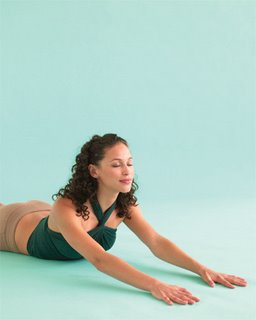 seal yoga pose Monday: Take a Deep Breath
One minute, you’re enjoying your Sunday coffee, lounging on the sofa. The next, it’s Monday morning and your alarm’s going off. The weekend has come to a screeching halt, but the transition doesn’t have to feel like whiplash. This posture helps you greet your week head on, with a clearer, calmer perspective.
Seal Pose
What It Does
Stretches the belly and aids digestion, restores the curve in the lower back, helps protect the spine from long hours of sitting.
How to Do It
Lie on your stomach with your legs and feet relaxed. Then, reaching your arms forward along the floor, straighten them just enough to lift your torso into a gentle backbend.
Do not strain or force; this should be a very passive and subtle stretch. Set your Zen Yoga Timer to chime after 5 minutes. Hold for 3 to 5 breaths, then release. Repeat for 5 minutes or until your Zen Timer ends your practice.
adapted from Body + Soul, 2010
 B Tone Digital Zen Yoga Timer in a Bamboo Finish Now & Zen
1638 Pearl Street
Boulder, Colorado
(800) 779-6383
Posted in Japanese Inspired Zen Clocks, mindfulness practice, Yoga Timer, Yoga Timers by Now & Zen
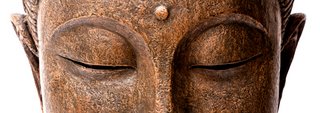 Buddha Maybe your next vacation should be a journey inward.
On the path to the hot springs at Tassajara Zen Mountain Center, I begin a kind of walking meditation, a continual awareness of what I am doing right now. Now I am crossing a footbridge to the baths, now I am taking off my flip-flops, now I am standing in front of an altar and reading the calligraphy: “With all beings/I wash body and mind/free from dust/pure and shining/within and without.”
“Guess my name,” says the little girl who shares the Japanese-style outdoor pool with me.
“Okay. Emma,” I say.
“Do you know her?” her mother asks, puzzled.
“No,” I say, “she just looks like an Emma.”
I’m not clairvoyant, but at retreat centers people converge in unexpected ways. Beyond the pool, past the sun-bleached sycamores on the far side of the creek, seven naked women in sun hats carefully wind their way upstream. There’s something mischievous about them as they wander in haphazard single file. I try to give them a context: Are they workshop participants hunting for wild mushrooms? Who knows? I think of the Zen notion of beginner’s mind, ready for anything, open to everything…and, silently, I thank Emma and the naked women for being here, for opening my mind.
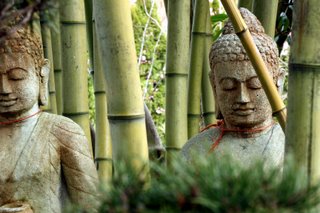 Buddhas In my mid-30s, I became an inveterate retreater. With two small kids, time to myself seemed a thing of the past. So I began to take week-long breaks, alone and seeking contemplation, at cabins, in farmhouses, on islands. Along the way, I discovered one retreat that offered me contemplation as a way of life shared by an entire community. Tassajara is the place I return to year after year.
Slowing way down is the first gift of Tassajara, and slow is the only way to drive the 14-mile dirt road that climbs through the Los Padres National Forest and over a 5,000-foot ridge of the Santa Lucia Mountains to the retreat. I stop and look down the steep descent through firs, sugar pines, tanbark oaks, and madrone into the canyon cut by Tassajara Creek. I exhale deeply, sloughing off my half-day drive south from San Francisco and a few layers of anxiety that have accumulated since my last visit here — the war and its threat to all of us with draft-age children, my divorce driving its way toward finality.
An open gate leads travelers to Tassajara, also known as Zenshin-ji (Zen Mind Temple), founded in 1966 by Japanese Soto Zen priest Shunryu Suzuki Roshi and the San Francisco Zen Center. The first Soto Zen monastery outside of Asia follows a traditional monastic schedule during the fall, winter, and early spring, then opens for guest season from late April through early September.
At Tassajara, where electricity is largely confined to the dining room and kitchen, cell phones don’t work, and a single public telephone is more trouble than it’s worth, guests are offered another way — the way of retreat. Here, the scheme of things is clear. One’s small place in it, uncomplicated.
 Digital Zen Alarm Clocks and Timers, available in maple, walnut, bamboo, and black lacquer Whether here or elsewhere, there are a number of ways to have a retreat. Retreats are times to turn inward, to quiet down, to let your own needs take precedence. At Tassajara, free from cars, buses, jobs, and family responsibilities, you simply bathe, eat, sleep, sit in meditation (or not, as you choose), swim, hike, read. You might venture to the massage kiosk to be kneaded, tapped, stretched, and unblocked. The day’s big excursion could be swimming some laps in the spring-fed creek-side pool, or hiking a mile downstream to a tumble of large boulders and small waterfalls you can ride down to the local swimming hole. Feeling more energetic, you might hike one of the trails — my favorite being up the mountain to the Wind Caves, where you can sit inside shallow, white-sand-floored pockets in the granite cliff face and behold the top of the world. You can return for the organic vegetarian meals, a cuisine pioneered by Tassajara’s Ed Brown and Annie Somerville, the chef of the Zen Center’s San Francisco restaurant, Greens.
Another way of visiting Tassajara is as a workshop participant. “Zen and Yoga” marks a turning point in my retreat life — a threshold to greater community, one that adds structure to my retreat time. With my daughter away at college and my teenage son spending every other week at his dad’s, I no longer crave alone time as I once did. Instead, I’m looking for ways to realign myself in relationship to others. In this context, retreat becomes an active verb.
My workshop takes place in the meditation hall, or zendo, where over the next three days we will examine how sitting meditation and the practice of yoga postures, or asanas, inform and enhance one another. I have brought my Zen Meditation Timer to end my meditation. It’s taught by Victoria Austin, a long-time Zen priest and yoga teacher who is also president of the San Francisco Zen Center. The afternoon we arrive, Victoria introduces us to the statue of a sitting Buddha that dominates the altar in the middle of the hall. When a fire destroyed the old zendo some years ago, the stone statue exploded into hundreds of pieces. Painstakingly reconstructed, the Buddha is almost exactly like the original, but not quite. “This Buddha is like practice itself,” Victoria reminds us. “You’re always putting yourself back together, each time a little differently.” I can relate to that; we all can. Practice reaches far beyond the yoga or meditation mat to include, ultimately, each moment of our waking lives.
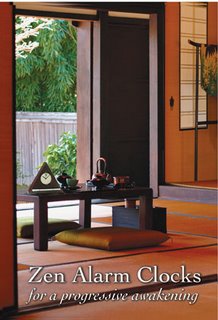 Tea Room with Zen Clock and Timer After restorative yoga, dinner, and an evening plunge in the hot springs, I’m as relaxed as I’ve ever been, in a comfy bed in my roomy turn-of-the-century cabin, lulled to sleep by the sound of water tumbling over creek stones. I’m awakened before dawn by the boom of a mallet striking a wooden block, calling the entire community to meditate in the zendo. An hour of sitting sorely reminds me of all the muscles it takes to sit that long, that straight. After temple cleaning, my workshop group continues with asana practice, all 25 of us spread out over the zendo, assuming Mountain, Tree, and Triangle poses, the Warrior series, and all the standing poses to fully awaken.
Famished, at breakfast I have a hard time choosing between the offerings: polenta with fresh strawberries, kiwis, and bananas, and the pancakes with raspberry compote. I sit at a table in the dining hall overlooking the creek with three women stem-cell researchers from Stanford University, a woman running for county supervisor, and a Minnesota man who founded a successful marketing firm. Busy lives and type-A personalities are a common bond for many people attracted to retreats.
Later that day, I talk to the gregarious guy from Minnesota. “I’m usually shy and standoffish, judgmental,” he admits to me, “but I decided to pay attention yesterday during sharing time.” He pauses to let a little cynical emphasis grin through. “I felt completely drawn to each story; it made me want to engage with everyone here.” I found myself wishing I’d done that. “Funny what’s possible,” he says.
It’s been a day of intense physical work, experimenting with yoga poses that help strengthen our meditation posture and focus our attention. Lying still, during Savasana, our last pose, Victoria says to us, “Let sounds come to you rather than pulling in the sounds.” I drift in and out, aware of the sound of footsteps on the gravel path, of the squawk of the ubiquitous blue jays, but most of all of our sighing — an ongoing chorus vocalizing the deep pleasure of exertion and release, a natural by-product of the primary work we are doing: following our breath in and out.
The next night at Victoria’s dharma talk, she compares the monks’ winter practice at Tassajara to one long breathing in, or refreshing the practice, and the summer guest season to a long breathing out, or giving to the larger community. I resolve to work on that out-breath.
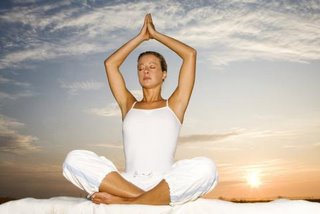 yoga Afterward the low light of kerosene lanterns dimly illuminates the path back to my cabin. I stop to watch the new moon rising above steep black slopes.
It is summer solstice night. Looking deeper, into the bright and scattered stars, I feel as if I’m standing in a roofless cathedral, buttressed by the Santa Lucias, part of some great force tilted upward in praise. My body tingles from the demands of the day, fledgling upper-back muscles awakened, all my cells celebrating in active communion. Attention. I whisper the word to myself, like an ancient secret. I raise my arms to the new moon in thankful salutation, take a long breath in, and sigh it westward, down the path of the year’s longest day.
For reservations call (415) 865-1895 or visit sfzc.org/tassajara/.
Adapted from Body + Soul, April/May 2005
Posted in Bamboo Chime Clocks, Hot Springs, Japanese Inspired Zen Clocks, Meditation Tools, mindfulness practice, Now & Zen Alarm Clocks, Well-being, zen monks
« Previous Page — « Previous Entries
Next Entries » — Next Page »
|
|
|
|